
Henry Cohn Gives the 2014 Arnold Ross Lecture at The Leonardo in Salt Lake City, Followed by Who Wants to Be a Mathematician
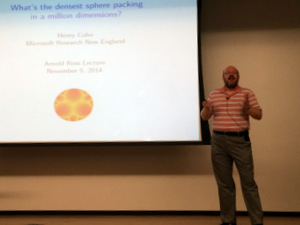
Over 150 high school students and teachers from the Salt Lake City area took advantage of a great opportunity to hear Henry Cohn (Microsoft Research and MIT) deliver the 2014 Arnold Ross Lecture, "What's the densest sphere packing in a million dimensions?" at The Leonardo in Salt Lake City on November 5. Following the lecture, and some well-received snacks, eight of the students played Who Wants to Be a Mathematician.
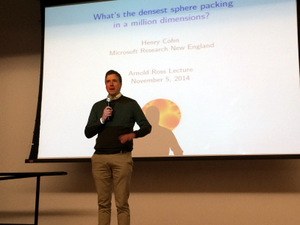 |
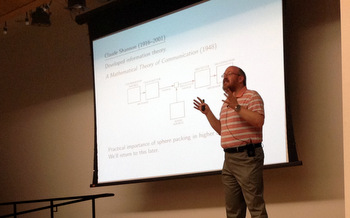 |
What's the densest sphere packing in a million dimensions?
Peter Trapa (above left), chair of the Arnold Ross Committee and of the University of Utah Department of Mathematics, welcomed the audience to the lecture, giving some history of Arnold Ross, the lecture series, and of Cohn. He explained that the lecture series was made possible by Paul Sally, whom Trapa said was "a fantastic guy and a towering man who looked--and swore--like a swashbuckling pirate." Cohn is a former student of PROMYS, an off-shoot of the Arnold Ross Program for high school students, and is now a PROMYS Foundation trustee. Later he was one of the founding members of Microsoft Research New England.
Cohn explained that sphere-packing involves filling space with spheres efficiently. Although how to do this in three dimensions has been known for a while (witness oranges in the produce section), it took 300 years to find a proof that the standard packing is the most efficient, and how to pack efficiently in higher dimensions is neither easy to see nor prove. Cohn traced the history of the problem, alluding to Thomas Harriot, who was the first to study the problem even though Kepler's name is attached to it, Claude Shannon, who showed that high-dimensional sphere packing is relevant to how to communicate effectively, and Alicia Boole Stott, who could visualize the problem and other structures in four dimensions.
In communication, signals always have noise. The noise can be thought of as introducing an error term to the original signal. Communication channels should be designed so that signals are spaced far enough part so that a received signal, assumed to have noise, determines only one sent signal. Signals can be thought of as points in space and the error can be thought of as a distance, d. Requiring that received signals determine the original signal is like requiring that spheres of radius d centered at received signals don't overlap. The best channels will be able to carry many signals with no overlap. So creating the best channels is equivalent to efficient sphere-packing.
Cohn explained the curse of dimensionality: Volume scales as 2n in n dimensions, so that the space's volume increases exponentially with the dimension, which makes searching difficult. He noted that today almost all data is high-dimensional, so even though spaces of 1,000 dimensions, for example, may seem unusual, it is actually the lower dimensions of two and three that we are used to which are anomalous. He also explained that "math = freedom" in that, for example, dimensions need not be length or width, but can be anything.

Throughout his lecture, Cohn encouraged questions, often pausing to give people time to ask a question, and audience members asked many. When he was done, he received a standing ovation. See slides of the lecture.
Slideshow from the lecture and game:
Created with flickr slideshow.
Who Wants to Be a Mathematician
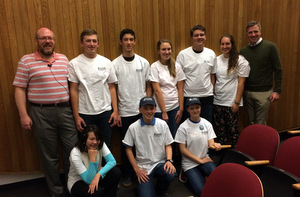
Front (left to right): Hanna Gilman, Utah Military Academy, Joseph Cieslewicz, Wasatch High School, Ruby Thorn, Academy for Math, Engineering and Science; Back: Henry Cohn, Aaron Carlisle, Salt Lake Center for Science Education, Caden Stewart, Weber High School, Elizabeth Haroldsen, Wasatch High School, Hunter Schmidt, Academy for Math, Engineering and Science, Noa Bauman, City Academy, and Peter Trapa.
Below are descriptions of the games followed by videos from the games:
Game One:
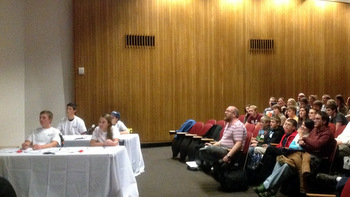 |
Aaron Carlisle won this game, followed by Ruby Thorn in second place, and Elizabeth Haroldsen and Caden Stewart, who tied for third. Aaron's win earned him $500 from the AMS, a TI-Nspire CX from Texas Instruments, and a spot in the Square-Off Round against the eventual game two winner.
|
Game Two:
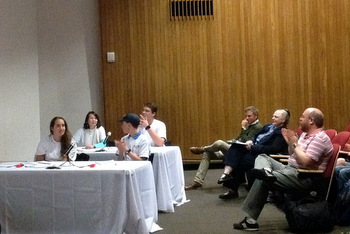 |
It wasn't easy finding Aaron's Square-Off Round opponent as game two was not only close, but wound up in a first-place tie between Joseph Cieslewicz and Hunter Schmidt. In the game, Joseph answered the first five questions correctly to secure first place comfortably heading into question six. Hanna was the only contestant to answer #6 correctly, which moved her into second, 100 points behind Joseph. Hunter was the only one to answer question seven correctly, which put him into a tie with Joseph going into the last question. At this point, 400 points separated the four contestants so there was a great deal of suspense going into the last question, but no one answered it correctly, which meant a tie-breaking question was needed. |
Tie-Breaker:
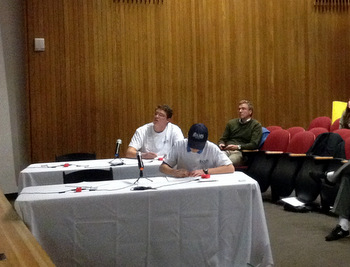 |
This question turned out to be much more difficult than intended and after considerable time, and one attempt each from Joseph and Hunter, Hunter answered correctly to earn the same cash and prize as Aaron had earned in game one. Hunter's correct answer earned him a spot in the Square-Off Round with Aaron for a chance at another $500 and a shot at the $2,000 Bonus Question. |
Square-Off Round and Bonus:
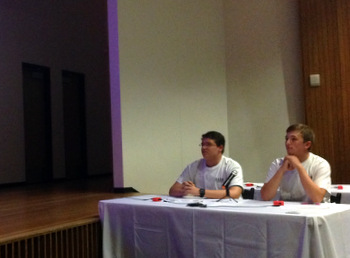 |
The Square-Off Question was a bit easier than the tie-breaker, and Hunter was the first to answer correctly. After a few seconds to catch his breath, Hunter moved to the Bonus Round for a chance at another $2,000. The question involved geometry, with the formula for the volume of a pyramid being important. Unfortunately, Hunter couldn't recall the formula and didn't answer correctly, but he still earned $1,000 and a TI-Nspire CX. |

Prizes and money won that day:
- TI-Nspire CX from Texas Instruments and $1,000 from the AMS: Hunter Schmidt
- TI-Nspire CX from Texas Instruments and $500 from the AMS: Aaron Carlisle
- Maple 18 from Maplesoft: Ruby Thorn and Joseph Cieslewicz
- Calculus by Anton, Bivens and Davis from John Wiley and Sons: Caden Stewart and Noa Bauman
- What's Happening in the Mathematical Sciences, Vol. 9 and Mathematics Everywhere from the AMS: Elizabeth Haroldsen and Hanna Gilman
Thanks to the audience, which was extremely enthusiastic in its support of the contestants, but quiet while contestants were thinking, and especially to the teachers who arranged for their students to participate in the 2014 Arnold Ross Lecture. The AMS also thanks sponsors Texas Instruments, Maplesoft, and John Wiley and Sons for their continued generous support of Who Wants to Be a Mathematician, The Leonardo for hosting the event, and Kylie Germain of the museum who helped arrange everything.
Photographs and video by Robin Aguiar, AMS Meetings and Professional Services. Text and other photos by AMS Public Awareneness Officer and Who Wants to Be a Mathematician emcee Mike Breen.
Find out more about the Arnold Ross Lecture series and Who Wants to Be a Mathematician.

